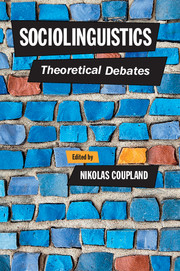Book contents
- Frontmatter
- Contents
- List of contributors
- Preface and acknowledgements
- 1 Introduction: Sociolinguistic theory and the practice of sociolinguistics
- Part I Theorising social meaning
- Part II Language, markets and materiality
- 6 Treating language as an economic resource: Discourse, data and debate
- 7 Theorising the market in sociolinguistics
- 8 Embodied sociolinguistics
- Part III Sociolinguistics, place and mobility
- Part IV Power, mediation and critical sociolinguistics
- Part V Sociolinguistics, contexts and impact
- Part VI The evolution of sociolinguistic theory
- Index
- References
7 - Theorising the market in sociolinguistics
from Part II - Language, markets and materiality
Published online by Cambridge University Press: 05 June 2016
- Frontmatter
- Contents
- List of contributors
- Preface and acknowledgements
- 1 Introduction: Sociolinguistic theory and the practice of sociolinguistics
- Part I Theorising social meaning
- Part II Language, markets and materiality
- 6 Treating language as an economic resource: Discourse, data and debate
- 7 Theorising the market in sociolinguistics
- 8 Embodied sociolinguistics
- Part III Sociolinguistics, place and mobility
- Part IV Power, mediation and critical sociolinguistics
- Part V Sociolinguistics, contexts and impact
- Part VI The evolution of sociolinguistic theory
- Index
- References
Summary
More than forty years since it first appeared, it is interesting to speculate about how Labov's (1972) department store study would be reviewed, received, and perhaps framed in a sociolinguistics journal today. Reading his paper from a contemporary perspective, the three department stores used in the study come across as sites primarily selected for finding and observing socially distinguishable groups interacting in three differently stratified shops. This is, I would argue, in contrast to the current approach which might place the commodification of accent at the heart of the analysis. In this chapter, I would like to explore what has happened in the intervening forty-plus year period, both in sociolinguistics and in society, to transform the market from one of a number of domains of everyday interaction to an overriding concern in contemporary sociolinguistic studies.
The chapter starts with a brief overview of the treatment of the market in early sociolinguistic research, using Labov's study as an illustration to show how markets were treated in much the same way as other domains where sociolinguistic data could be gathered. I then go on to argue that two main developments challenged this treatment of market domains. The first was Bourdieu's (1991) conceptualisation of the linguistic market, in which he advocated on the one hand a recognition of the economic foundations of all linguistic exchanges, whilst on the other arguing for the treatment of economic exchanges as just another type of exchange. The second was the development of Critical Discourse Analysis (CDA), particularly the British School, led by Norman Fairclough (e.g.1995; 2001), a key objective of which was the unmasking of the pervasiveness of market discourses across society. This period in sociolinguistics can be seen as one in which the domain of the market was put under a critical spotlight, largely in response to increasing marketisation of society and neoliberalism in the global political economy.
Having reviewed these two developments, the chapter moves on to the current period, in which the market is no longer restricted to a particular domain, but potentially impacts on all aspects of language in society.
- Type
- Chapter
- Information
- SociolinguisticsTheoretical Debates, pp. 157 - 172Publisher: Cambridge University PressPrint publication year: 2016
References
- 5
- Cited by



